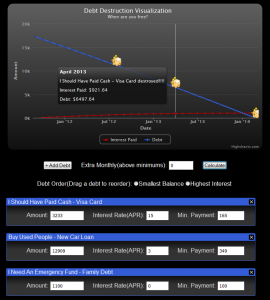Tools For Debt Reduction : Debt Snowball Calculator
 If you are interested in a modern graphical version of a debt calculator, check out this free graphical debt reduction calculator. We will be adding features as the feedback rolls in, so feel free to check it out and leave some suggestions by clicking the “Feedback” tab. To the right is a screenshot:
If you are interested in a modern graphical version of a debt calculator, check out this free graphical debt reduction calculator. We will be adding features as the feedback rolls in, so feel free to check it out and leave some suggestions by clicking the “Feedback” tab. To the right is a screenshot:
Also, over at What’s The Cost I came across a handy debt snowball calculator. The calculator lets you add up to 20 debts, their interest rate and monthly payment, and asks for how much money you can put each month towards debt. From there it will generate a nice text summary of the snowball calculations, some stats against consolidating your loans, and a nice table that plans out the snowball month by month.
The part that I think is really interesting is that it will let you chose between paying off the highest interest debt first and the Dave Ramsey method of the smallest debt first.
I loaded the calculator with 3 debts which should be a bad scenario for the Dave Ramsey snowball:
10,000 @ 12% for student loans
4,000 @ 5% on a credit card
3,000 @ 1% to finish off a new car loan
The results were interesting. Both methods will take 24 months to pay off the debt, and the Ramsey snowball will pay $254 more in interest($1,661 vs. $1,407). For me, this is more evidence to go with the Dave Ramsey method of changing our spending patterns. This method changes behavior by helping us experience positive change through small debt payoff wins. The difference in the amount of interest between the plans is negligible, and most people who are just starting to get out of debt need behavioral changes, not absolute perfect math.
So have fun, play with the numbers, and kick your debt to the curb!
If that calculator isn’t enough or you are interested in something more updated check out this free graphical debt reduction calculator.


There seems to be a problem with the link to the calculator …
Fixed. Thanks CFO, it seems to have gotten messed up when I fixed a grammar error.
Cool calculator. I’ve heard of the snowball method, and I always thought the same thing. Why not pay off the small balances first? What if my $150,000 mortgage has the highest interest rate, should I really pay that off before a credit card balance of say $2,000 which is only a slightly lower rate? It just doesn’t make sense, so thanks for the affirmation!
Right, this isn’t a one rule fits all type of situation. Dave’s advice may work in general but there are many cases where it isn’t the best method. Each person should consider the options and measure them against his own personality and his own debts. Using the best method for your situation will always give you the best results.
Great tool cheers. I’ve always been a fan of paying the small debts off first. I divide them up into primary, secondary and tertiary. The primary debts are made up of personal debts or small debts to local companies, the secondary debts include credit cards and small loans. The tertiary debts include my mortgage. I concentrate on primaries first and so on. This seems to help me deal with the pressure of it all.
Thanks for the link to the calculator will find it very useful nice post
I know some people criticise calculators like these but personally I think that any tools that help people get a handle on their financial comitments and assist them in paying down debt are an excellent idea. I do still really like Dave Ramsey and his approach to dealing with debt